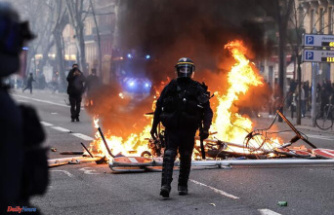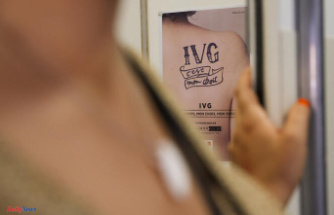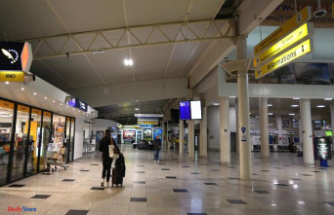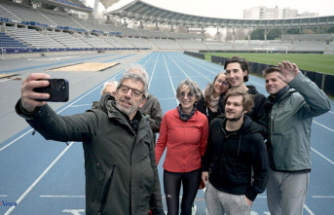THE WORLD is moving exclusively to the discovery of two novels and a memoir, unpublished to the Nobel prize egyptian when he sees the light a collection of short stories, astray
"despite all that I have seen and heard, I don't know of any similar period in the life of our neighborhood as the one that is called 'vintage black'". It is the beginning of one of the stories previously unpublished in the egyptian Naguib Mahfooz, the only arab whose prose has earned up to the date the Nobel Prize for Literature. The serendipity of a collection of short stories, dossiers lost in a folder, it offers a new look at the district of Gamaleya, the maze of alleyways of islamic Cairo, which constituted the universe of her work.
"Are wonderful stories. My father always liked to write about its habitat. Take place in the same scenario, among people full of superstitions", advances to THE WORLD Um Kulthum, the daughter of the novelist and the executor of the small legacy that she left in the apartment that he inherited from his parent, in the district cairene of Sharpens. Within the walls of your home, under sheets of papers, Um Kulthum came up with the manuscript that the publisher of lebanon, Saqi Books published in Arabic on the 11th of December, coinciding the birth of the writer who died in 2006 at the age of 94.
"I told his daughter that he sensed that Mahfooz had left unpublished. Two months ago he called me to warn me that he had found something. The folder contained short stories written between 1993 and 1994. In total, 40 stories, of which 22 had already seen the light in one of its last volumes. The remaining 18 are previously unreleased," explained to this newspaper Mohamed Shoair, critic and journalist, from the office of the state newspaper in which he works. "All the pieces are focused on a single location, 'the neighborhood', and at least two figures appear in almost all of them: the 'shaykh al harah', the head of the neighborhood and the 'imam al-zawiyah', the imam of the mosque and local school", he gives in conversation with this newspaper, the arabist Roger Allen, professor of the american University of Pennsylvania and author of the English translation, which will arrive in bookstores next year. "The main focus of these stories is the impact of the invisible, the hidden, the unknowable on one or several characters. A person in the neighborhood to visit an enigmatic place where they are produced to often encounters with mysterious forces that lead the witness to go back among their neighbors and provoke or instigate significant changes in the behavior of the most illustrious citizens of the wasteland", he adds.
"we have No way of knowing what were the intentions of the author about your publication. Could be part of a longer and unfinished", adventure the translator. The stories would have been lit months before that in October 1994, the author of The Alley of the milagrosfuera stabbed to death by a fundamentalist islamic at the doors of your home. He survived the assassination attempt but suffered the physical injuries that departed from the scripture and show several notebooks found also next to the stories, where the then octogenarian scribbles repetitive phrases as a year of convalescence for his recovery.
"The background of the attack is the Children of our neighborhood, originally released in 1959 that was censored of sacrilege by Al Azhar. Mahfooz agreed not to publish ever in book form, but when Salman Rushdie published his Satanic Verses, the egyptian refused to convict him and a cleric, Omar Abdelrahman, issued a fatwa [religious edict] calling for the death of Mahfooz. Almost achieved", recalls Allen. The collection discovered, the testimony of that convulsive year, oozes fable and irony to describe the society's wealth, trapped in their contradictions and longings. "It is a wonderful news for fans of one of the novelists most dear in the world", held from the editorial. Contacted by this newspaper, the agent in charge of negotiating the rights of the work confirms that, for the moment, the efforts of their publication in Spanish have not come to fruition.
Two new novels and an autobiographyThe search for Shoair, impervious to discouragement, has given other unexpected consequences that THE WORLD is moving in a premiere: the discovery of two new novels, and an autobiography. "The first novel dates from when Mahfooz was still a teenager. He was barely 18 years old and I don't think you see never the light because it is a test, part of the training of anyone who wants to be a writer. What's more interesting is that he anticipates his universe and meet characters such as Aisha, who then will make up his Trilogy of Cairo", describes the journalist. The second work took shape decades later, in the 80's, before or after the Swedish Academy awarded the Nobel prize. "It is based on Sadiq, one of the four characters featured in The coffee Qúshtumar. It is a good novel of about 70 pages but I don't know the reason why Mahfooz decided not to publish it in life. I don't know if it was written before or after Qúshtumar," admits the reporter, who prepares the second installment of a trilogy based on Mahfooz.
The third jewel is an autobiography on the childhood of the novelist. It was located in the hands of a collector of the Persian gulf who bought the manuscript in the 1980s when a cousin Mahfooz sold without your permission bundles of papers that were in one of their apartments. "The autobiography stops toward the ten years of life when her father decides to leave Gamaleya and move to Abasiya [another district of Cairo]. It is a decisive moment in its existence because the transfer is a journey through time. Moving from tradition to modernity, a place where they still used gas lamps to another where he had come as the light", tells of the Shoair.
Among the documents recovered, also include some of the screenplays that prepared and even your birth certificate. "There is still material lost. In one of the interviews that he gave he spoke of a series of papers that developed between 1940 and 1955 that have not been found yet. I am also looking for the notebook that he used as a guide to create his Trilogy, where noted the description of the characters and the themes because they are afraid of forgetting the details during a process that lasted for four years." For Shoair, Mahfooz is an "iceberg". "We always said that we should look for in their novels. What I attempt is to seek him in interviews, in their files and details. In manuscripts such as the Miramar, for example, you perceive how between the first and the last draft introduced a lot of modifications. There are characters that appear in the first version and not even mentioned in the final. On many occasions, prefers to remove instead of add and try to Polish the language to make it more "poetic".
A corazonada that can open new doors in the work of Mahfooz. His daughter is surprised at the interest that continue to inspire the more than sixty novels known. "I get many offers to edit new editions in paper and ebook in all the world. The people still have a hunger to read them," says this retired with the memory still fresh of his father. "It was a kind friendly and fair with a great sense of humor. He always wanted me to become a writer and taught me the craft when I was little. Twelve years ago I wrote a story but then never more," he confesses between laughs.
According to the criteria of
Learn more Date Of Update: 08 December 2018, 20:01











